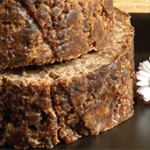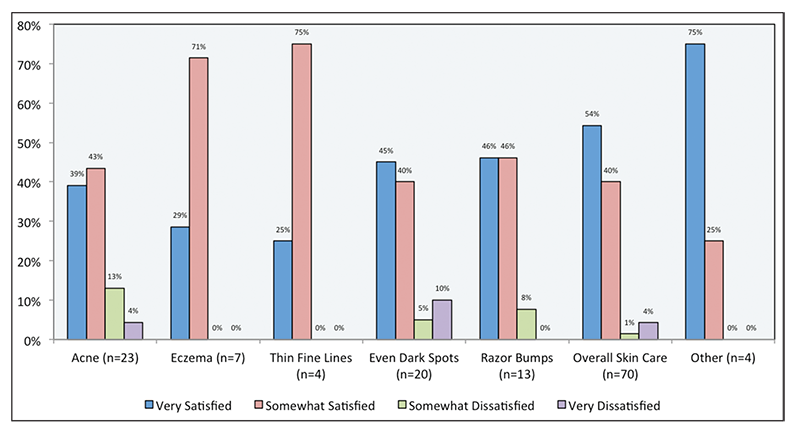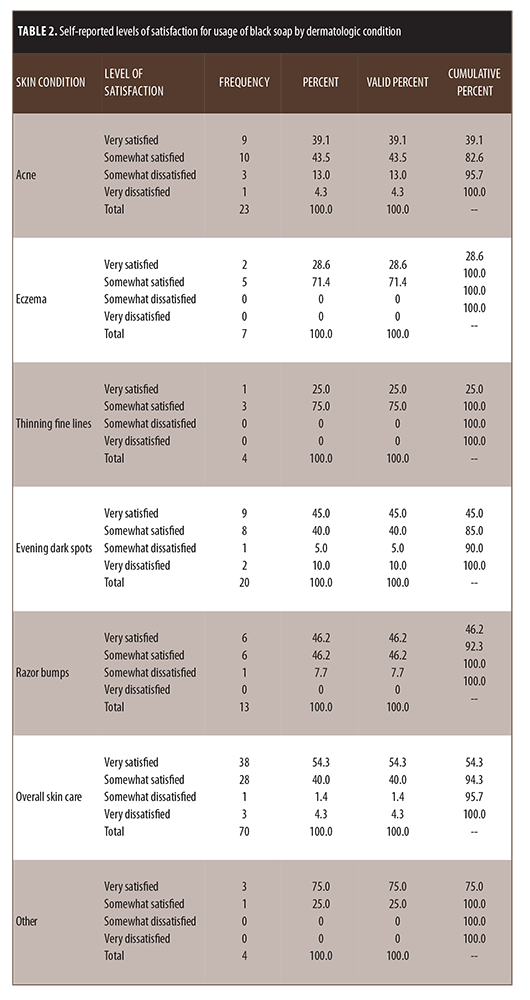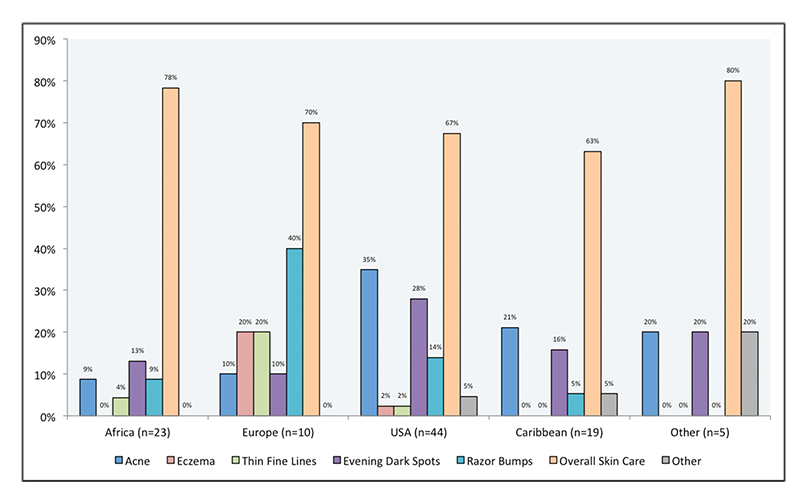 by Ann Lin, DO; Adam Nabatian, MD; and Caroline P. Halverstam, MD
by Ann Lin, DO; Adam Nabatian, MD; and Caroline P. Halverstam, MD
Dr. Lin is with Wlliam Carey University College of Osteopathic Medicine in Hattiesburg, Mississippi; and Drs. Nabatian and Halverstam are with Albert Einstein College of Medicine of Yeshiva University, Division of Dermatology in New York, New York.
J Clin Aesthet Dermatol. 2017;10(7):18–22
Funding: No funding was provided for this study.
Disclosures: The authors have no conflicts of interest relevant to the contents of this article.
Keywords: Black soap, Africa, Caribbean, dermatology
Abstract: Objective: The purpose of this study was to discover the general attitudes and practices of black soap users with regard to amelioration of various dermatologic conditions.
Design: This was a prospective questionnaire-based study with a sample size of 100 black soap users.
Setting: Outpatient dermatology clinics of Montefiore Medical Center and other Albert Einstein affiliated dermatology clinics in Bronx, New York.
Participants: One hundred subjects who have used black soap were recruited.
Measurements: The participants evaluated and reported their attitudes and applications of black soap. Data on sociodemographic prevalence and user satisfactions of black soap were collected and analyzed.
Results: The age distribution of participants was uniform among the specified age categories: 1) 18 to 29 years; 2) 30 to 39 years, 3) 40 to 49 yesars, and 4) 50 years and older. The sex distribution favored women, comprising 74 percent of those surveyed. A significant number of participants were born in either Africa (23%) or the Caribbean (19%). Black soap usage was applied to mitigate many dermatologic conditions, including acne (23%), dark spots (20%), razor bumps (13%), eczema (7%), and fine lines (4%). The most popular usage was for overall skin care (70%). The vast majority of users found black soap helpful for their skin condition (51% very satisfied, and 40% somewhat satisfied).
Conclusion: The survey results indicate widespread usage and satisfaction with black soap for reduction in symptoms of various dermatologic conditions. Further investigations are warranted to discover active ingredients present in black soap that may unveil future therapeutic options for various dermatologic conditions.
Introduction
Black soap is well known in African cultures as an ancient remedy for healthy skin. The exact composition of black soap depends on its specific origin. Moroccan black soap, more traditionally known as Saboun Beldi, is composed of olive oil and potassium hydroxide (potash).[1] In Nigeria, black soap originates from the Yoruba words “ose dudu,” and is composed of palm oil, cocoa pods, and other ingredients produced in a traditional manner.[2] Regardless of its place of production, black soap is characteristically known in these African cultures for its quality to improve uneven skin tone, razor bumps, and quality of skin. It is also widely used for acne, eczema, and general skin care. Other properties, such as antibacterial[3] and anti-pest activity,[1] have been mentioned in some literature. Black soap is well known in African cultures as an ancient remedy for healthy skin. The exact composition of black soap depends on its specific origin. Moroccan black soap, more traditionally known as Saboun Beldi, is composed of olive oil and potassium hydroxide (potash).[1] In Nigeria, black soap originates from the Yoruba words “ose dudu,” and is composed of palm oil, cocoa pods, and other ingredients produced in a traditional manner.[2] Regardless of its place of production, black soap is characteristically known in these African cultures for its quality to improve uneven skin tone, razor bumps, and quality of skin. It is also widely used for acne, eczema, and general skin care. Other properties, such as antibacterial3 and anti-pest activity,[1] have been mentioned in some literature.
The usage of black soap has expanded to many regions of the United States due to immigration of various ethnic, non-American black soap users and the influence of verbal recommendations. Very little research literature has been published on the effects and properties of black soap, especially regarding its reported role in improving various dermatologic conditions.[3] The objective of this study was to look at the general attitudes and practices of black soap users who have self-reported its relative usefulness in ameliorating various dermatologic conditions. The results serve as a reference point for future expansion of black soap research worldwide.
Methods
The Albert Einstein College of Medicine (New York, New York) Institutional Review Board approved this epidemiologic survey study. The surveys were conducted at the outpatient dermatology clinics at Montefiore Medical Center and other Albert Einstein affiliated dermatology clinics. One hundred subjects were approached and selected if they were identified as users of black soap. The study excluded subjects less than 18 years of age. All participants provided verbal consent prior to conducting the survey, which contained 13 questions on basic background information of the subject, including age, sex, country of birth, parents’ country of birth, and specific details on their black soap usage.
Statistical analysis. Statistical analysis was performed with the SAS statistical software package (version 9.1, SAS Institute Inc, Cary, North Carolina).
Results
Table 1 provides data collection of 100 individuals that completed the black soap survey. The survey contained sociodemographic characteristics of individuals surveyed and black soap usage details.

The age distribution of participants was uniform among the following age groups: 1) 18 to 29 years (25%), 2) 30 to 39 years (21%), 3) 40 to 49 years (27%), and 4) 50 years or older (27%). The sex distribution showed female participation at 74 percent versus male participation at 26 percent.
The majority of the participants were born in either the Caribbean (19%) or Africa (23%), and comprised 44 percent of all surveyed. The remaining participants were born in the United States (43%), while five percent were born in Argentina, Belize, Philippines, or other Asian countries. An even higher majority of the participants reported having parents who were born in either the Caribbean (27%) or Africa (38%), which comprised 65 percent of all participants that have roots in those two regions in the world. Other participants reported having parents who were born in the United States (26%) and either Europe (4%) or other regions of the world (5% were born in Central America, Argentina, the Philippines, or other Asian countries).
Most black soap users (40%) were introduced to the product by another family member. Specifically, 30 percent of black soap users were introduced to the product by a parent, eight percent by a sibling, and two percent by other relatives. The remaining participants were introduced to black soap via recommendations by friends (34%) or others (1%). Seventy-three percent of those surveyed had at least one other family member that also used black soap; 24 percent did not have another family member who also used black soap.
Black soap usage for various skin conditions included acne (23%), dark spots (20%), and razor bumps (13%), eczema (7%), and fine lines (4%). The most popular usage was for overall skin care (70%) and all regions of the body (56% face and body). The users expressed overall satisfaction (51% very satisfied, 40% somewhat satisfied).
Figure 1 and Table 2 depict the self-reported levels of satisfaction for usage of black soap in concordance with the specific dermatologic condition. Users showed the greatest satisfaction in black soap for their overall skin care. Usage for a specific condition that granted the most satisfaction was for razor bumps (46.2% very satisfied, 46.2% somewhat satisfied), followed by dark spots (45% very satisfied, 40% somewhat satisfied).


Figure 2 illustrates that, regardless of the birthplace of the black soap users, the most common usage of black soap was for overall skin care, as reported by 78 percent of African-born respondents, 70 percent of Europe-born respondents, 67 percent of United States-born respondents, 63 percent of Caribbean-born respondents, and 80 percent of respondents born in other regions of the world. The data on black soap use for specific conditions (acne, eczema, fine lines, dark spots, and razor bumps) varied based on the user’s birthplace and did not show a specific pattern.

Discussion
This study demonstrates a preliminary understanding of the usage, effectiveness, general attitudes, and sociodemographics of black soap users. Black soap was used across all age groups (multigenerational), and the sex distribution favored women. In addition to multigenerational usage, these data suggest the widespread usage and satisfaction of black soap across different ethnicities and cultures.
More than half of the individuals surveyed were of either African (38%) or Caribbean heritage ( 27%). This may be due to a selection bias, as a large portion of the patient population visiting the Montefiore Medical Center and other Albert Einstein affiliated dermatology clinics are of African and Caribbean descents. However, the representation of black soap usage among other cultures indicates the spread of this practice. This observation is of interest for future research, as it demonstrates that the usage of black soap has disseminated across time and location since its presumed first use in Africa.
Most black soap users were satisfied with the effects that the soap product provided (51% very satisfied, 40% somewhat satisfied). Figure 1 data indicate that the majority of respondents who used the soap were either very satisfied or somewhat satisfied, regardless of which dermatologic condition for which it was used. However, this high satisfaction for black soap use could be attributed to participants’ bias of a product in which they have already invested money. In addition, most participants were introduced to the product through friends (34%) or family members (parent 30%, and sibling 8%), further influencing investment in product and satisfaction.
It is notable that black soap was rarely used for certain conditions. For instance, only seven percent of participants used black soap for eczema and only four percent used it for fine lines. Although these few respondents were satisfied with the product, the lack of usage may reflect a lack of efficacy for these skin conditions. The most popular uses were for overall skin care, treating acne, and evening out dark spots. Further investigation is warranted with regard to the value of black soap in ameliorating these dermatologic conditions.
Ogunsuyi et al[6] examined the making of soap using vegetable matter. They determined that the moisture content of black soap depends on the amount of insoluble ingredients in the soap. When the black soap was compared with two other soaps with varying ingredients and production processes, black soap demonstrated the lowest moisture content.[6]
A comparison of subjects’ satisfaction reported in various skin conditions may indicate that black soap is most effective in ameliorating acne and least effective for eczema; this possibly may be due to a potential drying effect of black soap. Adverse effects of black soap were not assessed in our study.
Conclusion
The survey results indicate multigenerational, widespread usage and satisfaction of black soap for reduction in symptoms of various dermatologic conditions. Since black soap encompasses a wide range of products with different compositions, more research is needed to investigate which ingredients are active in improving dermatologic conditions. Future studies to uncover how production differs among products may help to illuminate which ingredients are common to all products and which are variable. More specific studies of the efficacy of isolated ingredients in different skin diseases could also provide more information (e.g., an ingredient in coco pods may be beneficial for treatment of acne vulgaris). The ancient African remedy of black soap may be helpful in treating multiple dermatologic conditions, thus validating its widespread use over time and geography.
References
- Misdaq M, Outeqablit K. Determination of committed effective doses to skin due to ²³8U, ²³²Th and ²²²Rn from the application of various Moroccan black soap (Saboun Beldi) samples by members of the general public. Radiat Prot Dosimetry 2010;142:136–145.
- Taiwo O, Osinowo F. Evaluation of various agro-wastes for traditional black soap production. Bioresource Technol. 2001;79:95–97.
- George A, Ogunbiyi A, Daramola O. Cutaneous adornment in the Yoruba of south-western Nigeria – past and present. Int J Dermatol 2006;45:23–27.
- Geraldo I, Gilman A, Shintre M, Modak S. Rapid antibacterial activity of 2 novel hand soaps: evaluation of the risk of development of bacterial resistance to the antibacterial agents. Am J Infect Control. 2008;29:736–741.
- Egho E, Emosairue S. Evaluation of native soap (local black soap) for the control of major insect pests and yield of cowpea (Vigna Unguiculata (L) WALP in ASABA, Southern Nigeria. Agric Biol J N Am. 2010;1:938–945.
- Ogunsuyi HO, Akinnawo CA. Quality assessment of soaps produced from palm bunch ash-derived alkali and coconut oil. J Appl Sci Environ Manage. 2012;16:363–366.

